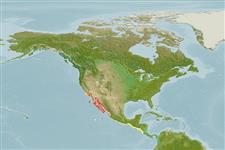Environment: milieu / climate zone / depth range / distribution range
Ecología
marino asociado a arrecife; rango de profundidad 1 - 61 m (Ref. 2850). Subtropical; 37°N - 10°N, 123°W - 85°W
Eastern Central Pacific: Monterey in California, USA to Mexico, including the Gulf of California. Also reported in Nicaragua (Ref. 13613).
Length at first maturity / Tamaño / Peso / Age
Maturity: Lm ?, range 9 - ? cm
Max length : 60.0 cm TL macho / no sexado; (Ref. 26550); peso máximo publicado: 900.00 g (Ref. 40637); edad máxima reportada: 20 años (Ref. 56049)
Usually found on sand or mud bottom near rocks and eelgrass, from the coast to a depth of 60 m. A secretive species, it feeds on small fishes and benthic crustaceans during the day (Ref. 9342). Capable of tolerating ample fluctuations of temperature (from 7.5 to 32°C) and survive extreme cold intervals (Ref. 9342). Pelagic spawners (Ref. 56049). Important game fish caught in bays and harbors (Ref. 9342). Minimum depth range based on occurrence (Ref. 79604).
Pelagic spawner (Ref. 56049). Protogyny (Ref. 32126) as proposed has been corrected by a more detailed study on several species which confirmed this species and all of the members of the genus to be gonochoristic (Ref. 103751).
Eschmeyer, W.N., E.S. Herald and H. Hammann, 1983. A field guide to Pacific coast fishes of North America. Boston (MA, USA): Houghton Mifflin Company. xii+336 p. (Ref. 2850)
IUCN Red List Status (Ref. 130435)
Threat to humans
Harmless
Human uses
Pesquerías: sin interés; pesca deportiva: si
Más información
ReferenciasAcuiculturaPerfil de acuiculturaRazasGenéticaElectrophoresesheritabilidadEnfermedadesProcesamientoNutrientsMass conversion
ColaboradoresImágenesStamps, Coins Misc.SonidosCiguateraVelocidadTipo de nataciónSuperficie branquialOtolitosCerebrosVisión
Herramientas
Special reports
Download XML
Fuentes de Internet
Estimates based on models
Preferred temperature (Ref.
123201): 18.1 - 26.8, mean 22.3 °C (based on 42 cells).
Phylogenetic diversity index (Ref.
82804): PD
50 = 0.5020 [Uniqueness, from 0.5 = low to 2.0 = high].
Bayesian length-weight: a=0.01288 (0.00809 - 0.02051), b=3.00 (2.88 - 3.12), in cm total length, based on LWR estimates for this species & Genus-body shape (Ref.
93245).
Nivel trófico (Ref.
69278): 4.1 ±0.56 se; based on food items.
Generation time: 3.7 ( na - na) years. Estimated as median ln(3)/K based on 1
growth studies.
Resiliencia (Ref.
120179): Medio, población duplicada en un tiempo mínimo de 1.4-4.4 años (tm=1.5; tmax=20; K=0.296).
Fishing Vulnerability (Ref.
59153): Moderate vulnerability (37 of 100).
Nutrients (Ref.
124155): Calcium = 20.5 [11.6, 42.9] mg/100g; Iron = 0.556 [0.279, 0.979] mg/100g; Protein = 19.4 [17.5, 21.0] %; Omega3 = 0.224 [0.132, 0.376] g/100g; Selenium = 16.4 [8.6, 32.5] μg/100g; VitaminA = 73.5 [24.6, 256.6] μg/100g; Zinc = 0.566 [0.368, 0.879] mg/100g (wet weight);
